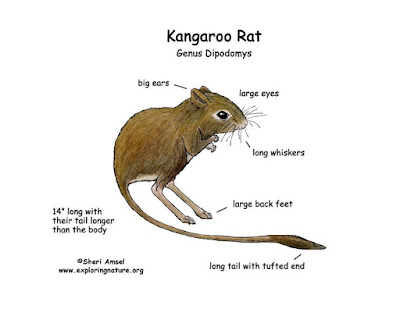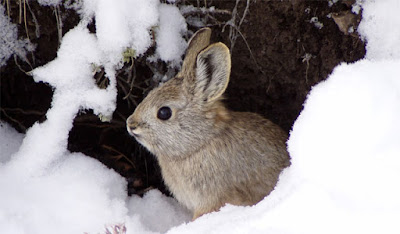Giant Kangaroo Rat
GIANT KANGAROO RAT
[GENUS DIPODOMYS]
Luany Albarracin Leone
Luany Albarracin Leone
Description and Ecology of Organism
 |
| https://www.exploringnature.org/db/view/Kangaroo-Rat |
Kangaroo Rats are secondary carnivore consumers. They primarily eat seeds but can also consume green plants (such as grasses) and some insects. When foraging, Kangaroo Rats collect seeds inside their fur pouches and then place them inside pits in the ground and cover them up with dirt. Furthermore, foraging and other general activities of the Kangaroo happen at night and they keep active all year long - no hibernation despite the collection of food.
 |
https://www.exploringnature.org/db/view/Kangaroo-Rat
|
The reproductive process of the Kangaroo Rat usually happens between December and March and is very responsive to climate, food availability, and population density. They have a very efficient life history as they can breed within their first year of life, can have 2-3 litters per year and their gestation period is only 30-35 days. This means that population numbers can rise very quickly.
When it comes to interactions with other rats Kangaroo Rats can be very aggressive. Nonetheless, they are crucial to certain environments and ecosystems. For example, they serve as significant prey for many species - such as the Kit Fox - and their burrows serve as shelter for Blunt Nosed Lizard and the Antelope Squirrel. As a result, Kangaroo rats are considered Keystone species in grassland and shrub areas
Geographic
and Population Changes
Historically, Giant Kangaroo Rats could only be found in grasslands with sandy gentle slopes where they could easily burrow, however, this is no longer the case. Unfortunately, most of the prime habitat for this species also happens to be prime areas for cultivation. As a result, Giant Kangaroo Rats can now also be found in areas of mild shrub communities with steeper slopes. At areas with steeper slopes, the Kangaroo Rats tend of inhabit the Chaparral Yucca plants that grow abundantly. They are also mainly found in areas with little to no flooding which can be a threat to their survival. As a result of cultivation and other fragmentation factors, the Giant Kangaroo Rat population today is split into 6 main regions: Fresno, Kettleman Hills, San Juan Creek Valley, Western Kern County, Carrizo Plain and Cuyama Valley.
 |
| http://esrp.csustan.edu/publications/pubhtml.php?doc=sjvrp&file=chapter02H00.html |
Listing
Date and Type of Listing
 On May 5th 1987, the Giant Kangaroo Rat was officially declared "State and Federally Endangered" within the California and Nevada region - USFWS. Today, it is considered endangered wherever found.
On May 5th 1987, the Giant Kangaroo Rat was officially declared "State and Federally Endangered" within the California and Nevada region - USFWS. Today, it is considered endangered wherever found.
http://esrp.csustan.edu/publications/pubhtl.php?doc=sjvrp&file=chapter02H00.html
Cause of Listing

https://www.ewg.org/enviroblog/2017/05/whos-watching-oil-and-gas-industry-california#.WgLStWWbI_U
Until early 1970s there was not much human intervention in the Giant Kangaroo Rat habitat. However, the development of the Central Valley Project as well as the rise of the California Aqueduct and State Water Project resulted in a rise of cultivation and irrigation. The main loss of habitat occurred through 1970 - 1979 main loss of habitat due to cultivation development as well as the increased use of rodenticide-treated grain. Rodenticides such as Compound 1080 were spread over large areas by airplane eliminating large numbers of Giant Kangaroo Rats within the area. In addition to cultivation, petroleum extraction was also a leading cause of habitat destruction. Also, the development of new cities on the edge of Fresno caused further habitat degradation and fragmentation due to the development of roads, highways and energy communication infrastructure.
 |
| https://www.ewg.org/enviroblog/2017/05/whos-watching-oil-and-gas-industry-california#.WgLStWWbI_U |
Until early 1970s there was not much human intervention in the Giant Kangaroo Rat habitat. However, the development of the Central Valley Project as well as the rise of the California Aqueduct and State Water Project resulted in a rise of cultivation and irrigation. The main loss of habitat occurred through 1970 - 1979 main loss of habitat due to cultivation development as well as the increased use of rodenticide-treated grain. Rodenticides such as Compound 1080 were spread over large areas by airplane eliminating large numbers of Giant Kangaroo Rats within the area. In addition to cultivation, petroleum extraction was also a leading cause of habitat destruction. Also, the development of new cities on the edge of Fresno caused further habitat degradation and fragmentation due to the development of roads, highways and energy communication infrastructure.
Main Threats to Survival
 |
http://departmentofagriculture.blogspot.com/2013/03/agriculture-in-california.html
|
Description of Recovery Plan
Full recovery of the Giant Kangaroo Rat species can only be achieved when the three largest populations are protected and managed properly. Kangaroo Rats are keystone species within their local habitat which means that their protection also ensures the safety and well being of many other species of animals and plants in their ecosystem. The main goal of the Giant Kangaroo Rat recovery plan is to protect the existing habitat and key local populations. Unfortunately, our understanding of the distribution demographics and population genetics is insufficient to presume if the species is threatened, therefore, more research in the area is needed. Studied responses to climate and environmental variation shows that random catastrophic events are a major threat to their survival. As a result, protection from this type of problem can be solved by protecting habitat areas with a wide range of habitat conditions.
Furthermore, it is also important to understand what land uses can provide optimum habitat conditions and determine ways in which to provide incentives for those types of land uses. Especially where the land acquisition is private.
Here are the steps:
1. Appropriate land use and management on publicly owned and conservation lands
2. Supporting research on habitat management + restoration (effects of livestock)
3. Protection of additional land supporting key populations
How can this be done? The goal is to protect 90% of natural land on east of California aqueduct and maintain the natural state of the land belonging to the Naval Petroleum reserves
How can this be done? The goal is to protect 90% of natural land on east of California aqueduct and maintain the natural state of the land belonging to the Naval Petroleum reserves
 |
http://departmentofagriculture.blogspot.com/2013/03/agriculture-in-california.html
how to prioritize populations
|
What can you do?
Its sometimes difficult to take action and make a difference instantly or directly. Therefore, there are not many ways in which you can contribute other than keeping yourself informed about the situation as well as to inform others. It is also important to keep an eye out of potentially illegal rat killing techniques (such as rodenticides). Finally, for those who are avid hikers and campers or just like to be in the wild, make sure to check if the area where you plan on going happens to be a habitat for a Giant Kangaroo Rat Population and try to stay on the manmade path in order to prevent destruction of burrows and other important habitat plants.
 |
| https://sites.google.com/site/sciencegolz/home/environmental-systems-and-societies/biology/one-big-experiment-ecology/lesson-8---food-webs |
Other resources
NatureServe Explorer Species Reports -- NatureServe Explorer is a source for authoritative conservation information on more than 50,000 plants, animals and ecological comuntities of the U.S and Canada. NatureServe Explorer provides in-depth information on rare and endangered species, but includes common plants and animals too. NatureServe Explorer is a product of NatureServe in collaboration with the Natural Heritage Network.
ITIS Reports -- ITIS (the Integrated Taxonomic Information System) is a source for authoritative taxonomic information on plants, animals, fungi, and microbes of North America and the world.
FWS Digital Media Library -- The U.S. Fish and Wildlife Service's National Digital Library is a searchable collection of selected images, historical artifacts, audio clips, publications, and video.
Bibliography
Williams, Daniel F. “Recovery Plan for Upland Species of the San Joaquin Valley, California.” Recovery Plan , U.S. Fish and Wildlife Services , 1998, www.fwspubs.org/doi/suppl/10.3996/052015-JFWM-045/suppl_file/052015-jfwm-045.s2.pdf?code=ufws-site+.
U.S. Fish and Wildlife Service. “Giant Kangaroo Rat (Dipodomys Ingens).” Species Profile for Giant Kangaroo Rat (Dipodomys Ingens), ECOS Environmental Conservation Online System, ecos.fws.gov/ecp0/profile/speciesProfile?spcode=A08P.
CSU Stanislaus. “H. Giant Kangaroo Rat (Dipodomys Ingens).” Endangered Species Recovery Program, CSU Stanislaus, esrp.csustan.edu/publications/pubhtml.php?doc=sjvrp&file=chapter02H00.html.



This was a very nice blog. You covered all the information and all sections were clearly labeled. I liked all the diagrams and pictures you had throughout your blog. The blog was readable and all the information made sense. The species that you picked I didn't know a whole lot about and now I feel much more informed. -Karah Bengs
ReplyDeleteYour recovery plan was very well written. Specifically, I liked how to ventured off into the comparisons that the Kangaroo Rat had with a Kangaroo in your opening paragraphs to give a clearer comprehension of its behavior and name origination. Also I liked how you gave a historical context into the transition of the Kangaroo Rat's current geographical locations. One suggestion that I would give is to somehow reintroduce the Naval Petroleum Preserve back into the "What Can We Do?" section because it was an apparent threat to your species in the beginning portion of your recovery plan. Maybe by the inclusion of petroleum alternatives that would be less harmful on the Kangaroo Rat's environment.
ReplyDelete-Sarah Bach
What an interesting creature! It is certainly distinct from other rats, and I feel it is aptly named. It is unfortunate that this creature has been displaced from its prime habitat due to agriculture. Overall, I feel that there is certain hope for the Kangaroo rat since they can have 2-3 litters per year, and begin breeding after only one year of age. I thought your blog was well organized and easy to read. Good job! -Lucas Bartell
ReplyDeleteThis is an extremely interesting species seeing how it is almost a hybrid of two seemingly very different creatures. Your blog was very well done - organized and easy to follow. -Haley Baquian
ReplyDelete